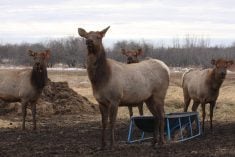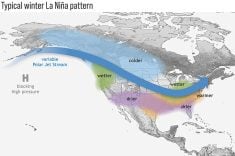NAPANEE, Ont. – Canadian Cattlemen’s Association president John
Morrison listened with growing dismay March 12 as farmers and
politicians praised the Net Income Stabilization Account program as a
safety net centrepiece that should be enriched.
He saw it as a disaster scenario for the cattle sector, which is
increasingly using NISA.
“NISA is something that makes us nervous.”
He said it could become a trigger for U.S. protectionist trade action
against Canadian cattle and beef imports.
Read Also

Canadian Food Inspection Agency extends chronic wasting disease control program consultation deadline
Date extended for consultation period of changes to CWD program
The scene was a meeting of the House of Commons agriculture committee,
which was travelling through Ontario and Quebec.
At the meeting in eastern Ontario, beef producer and feedlot operator
Paul Burns argued that an enhanced NISA is part of the solution to
future farm instability problems.
He proposed that farmers be helped to build a $200,000 NISA reserve
fund that would get them through extended disaster years.
The 62-year-old Napanee-area farmer said it would be “worst case
scenario insurance” and criticized federal officials who condemn
farmers for building up large reserves.
MPs on the committee were quick to commend Burns for his idea and to
agree that the federal government and agriculture minister Lyle
Vanclief have been too willing to condemn farmers and to insist that
NISA accounts be depleted before other forms of help are available.
“I wish you luck and I agree you have a selling job to do, starting at
the top,” said New Democrat MP Dick Proctor.
Morrison, who is president of the Canadian Cattlemen’s Association,
shuddered at the thought.
Later, he told MPs he would rather the government support agriculture
by paying for more Canadian Food Inspection Agency veterinarians.
More money into NISA is not the answer for his industry, Morrison said.
In a later interview, the cattle producer from the Kamloops, B.C., area
conceded that thousands in his industry have decided to build NISA
accounts for when they are losing money. Last year, the Alberta
industry decided to endorse NISA accounts and they have been available
in British Columbia and other provinces, he said.
However, Morrison said it is a mistake for a sector heavily dependent
on sales into the United States because the Americans consider NISA to
be a subsidy.
“Anytime you take a taxpayers dollar as direct payment into a
producer’s pocket, it’s a countervailable subsidy.”
It was part of a general anti-subsidy presentation by CCA leadership to
the MPs.
Morrison said the current review of national agriculture policy is a
good time to question the value of subsidies to any sector.
“I think when you put money directly into a producer’s pocket, you help
him for today, you are not taking care of him for tomorrow.”
While he quickly conceded he could speak most knowledgeably about
cattle, he figured the lesson extended to all sectors.
“That producer has to be less dependent on public funding and get out
and do what they have to do as an industry to market their product more
effectively, become more efficient if that is possible and look after
themselves rather than depend on big brother governments to help them.”














